The DirectX 12 Performance Preview: AMD, NVIDIA, & Star Swarm
by Ryan Smith on February 6, 2015 2:00 PM EST- Posted in
- GPUs
- AMD
- Microsoft
- NVIDIA
- DirectX 12
DirectX 12 vs. Mantle, Power Consumption
Although the bulk of our coverage today is going to be focused on DirectX 12 versus DirectX 11, we also wanted to take a moment to also stop and look at DirectX 12 and how it compares to AMD’s Mantle. Mantle offers an interesting point of contrast being that it has been in beta longer than DirectX 12, but also due to the fact that it’s an even lower level API than DirectX 12. Since Mantle only needs to work on AMD’s GPUs and can be tweaked for AMD’s architectures, it offers AMD the chance to exploit their GPUs in a few additional ways that a common, cross-vendor API like DirectX 12 cannot.
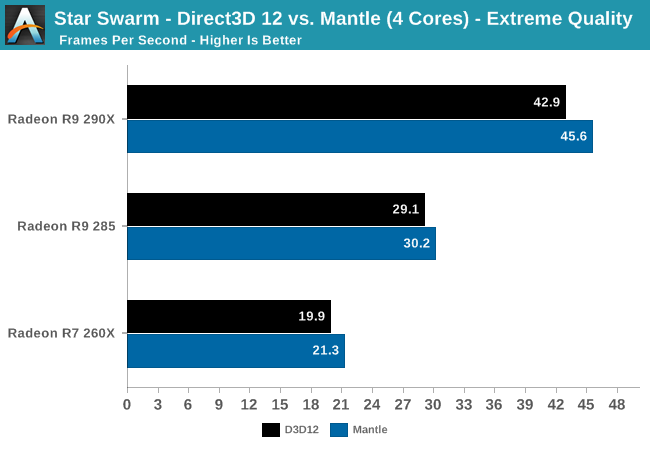
With 4 cores we find that AMD achieves better results with Mantle than DirectX 12 across the board. The gains are never very great – a few percent here and there – but they are consistent and just outside our window of variability for the Star Swarm benchmark. With such a small gain there are a number of factors that can possibly explain this outcome – better developed drivers, better developed application, further benefits of working with a known hardware platform – so we can’t credit any one factor. But it’s safe to say that at least in this one instance, at this time, Star Swarm’s Mantle rendering path produces even better results than its DirectX 12 path on AMD cards.
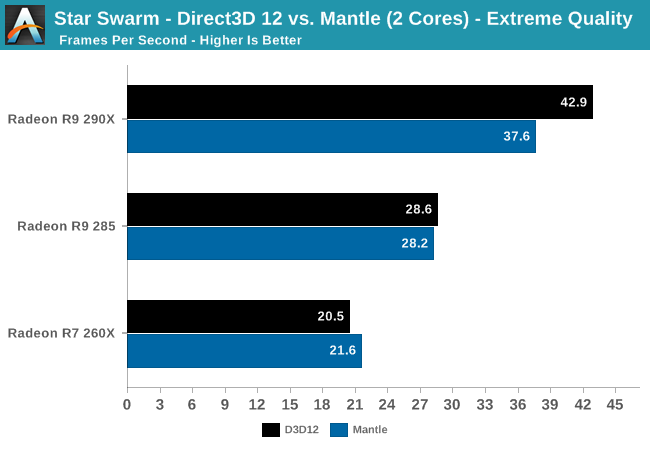
On the other hand, Mantle doesn’t seem to be able to accommodate a two-core situation as well, with the 290X seeing a small but distinct performance regression from switching to Mantle from DirectX 12. Though we didn’t have time to look at an AMD APU for this article, it would be interesting to see if this regression occurs on their 2M/4C parts as well as it does here; AMD is banking heavily on low-level APIs like Mantle to help level the CPU playing field with Intel, so if Mantle needs 4 CPU cores to fully spread its wings with faster cards, that might be a problem.

Diving deeper, we can see that part of the explanation for our Mantle performance regression may come from the batch submission process. DirectX 12 is unexpectedly well ahead of Mantle here, with batch submission taking on average a bit more than half as long as it does under Mantle. As batch submission times are highly correlated to CPU bottlenecking on Star Swarm, this would imply that DirectX 12 would bottleneck later than Mantle in this instance. That said, since we’re so strongly GPU-bound right now it’s not at all clear if either API would be CPU bottlenecked any time soon.
Update: Oxide Games has emailed us this evening with a bit more detail about what's going on under the hood, and why Mantle batch submission times are higher. When working with large numbers of very small batches, Star Swarm is capable of throwing enough work at the GPU such that the GPU's command processor becomes the bottleneck. For this reason the Mantle path includes an optimization routine for small batches (OptimizeSmallBatch=1), which trades GPU power for CPU power, doing a second pass on the batches in the CPU to combine some of them before submitting them to the GPU. This bypasses the command processor bottleneck, but it increases the amount of work the CPU needs to do (though note that in AMD's case, it's still several times faster than DX11).
This feature is enabled by default in our build, and by combining those small batches this is the likely reason that the Mantle path holds a slight performance edge over the DX12 path on our AMD cards. The tradeoff is that in a 2 core configuration, the extra CPU workload from the optimization pass is just enough to cause Star Swarm to start bottlenecking at the CPU again. For the time being this is a user-adjustable feature in Star Swarm, and Oxide notes that in any shipping game the small batch feature would likely be turned off by default on slower CPUs.
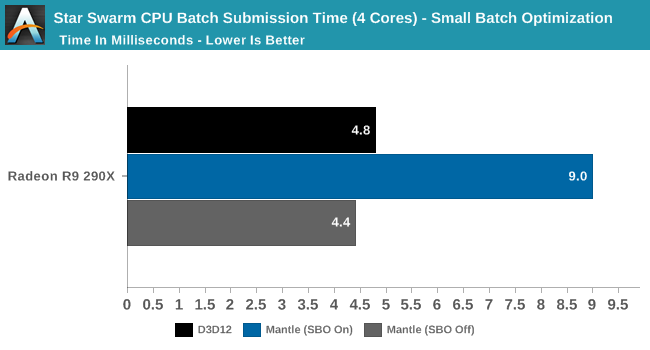
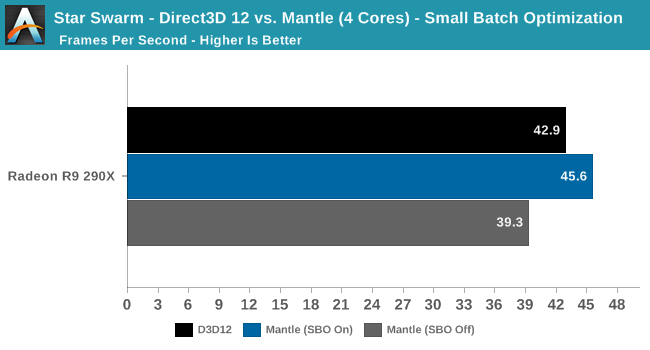
If we turn off the small batch optimization feature, what we find is that Mantle' s batch submission time drops nearly in half, to an average of 4.4ms. With the second pass removed, Mantle and DirectX 12 take roughly the same amount of time to submit batches in a single pass. However as Oxide noted, there is a performance hit; the Mantle rendering path's performance goes from being ahead of DirectX 12 to trailing it. So given sufficient CPU power to pay the price for batch optimization, it can have a signifcant impact (16%) on improving performance under Mantle.
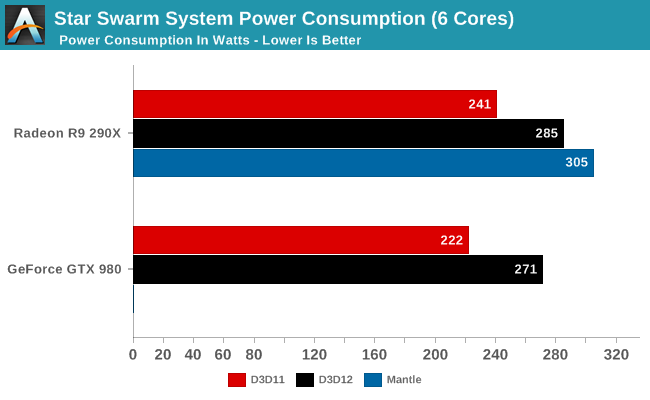
Finally, we wanted to take a quick look at power consumption among cards and APIs. To once again repeat what we said earlier, Star Swarm is an imperfect, non-deterministic benchmark, and coupled with the in-development status of DirectX 12 everything here is subject to change. However we thought this was interesting enough to include in our evaluation.
As expected, the increased throughput from DirectX 12 and Mantle drive up system power consumption. With the CPU no longer the bottleneck, the GPU never gets a chance to idle and video card power consumption ramps up to full load.










245 Comments
View All Comments
Jeffro421 - Thursday, February 12, 2015 - link
Something is horribly wrong with your results. I just ran this benchmark, on extreme, with a 270X 4GB and I got 39.61 FPS on DX11. You say a 290X only got 8.3 fps on DX11?http://i.imgur.com/JzX0UAa.png
Ryan Smith - Saturday, February 14, 2015 - link
You ran the Follow scenario. Our tests use the RTS scenario.Follow is a much lighter workload and far from reliable due to the camera swinging around.
0VERL0RD - Friday, February 13, 2015 - link
Been meaning to ask why both cards show vastly different total memory in Directx diag. Don't recall Article indicating how much memory each card had. Assuming they're equal. Is it normal for Nvidia to not report correct memory or is something else going on?Ryan Smith - Saturday, February 14, 2015 - link
The total memory reported is physical + virtual. As far as I can tell AMD is currently allocating 4GB of virtual memory, whereas NVIDIA is allocating 16GB of virtual memory.trisct - Friday, February 13, 2015 - link
MS needs a lot more Windows installs to make the Store take off, but first they need more quality apps and a competitive development stack. The same app on IOS or Android is almost always noticeably smoother with an improved UI (often extra widget behaviors that the Windows tablet versions cannot match). Part of this is maturity of the software, but Microsoft has yet to reach feature parity with the competing development environments, so its also harder for devs to create those smooth apps in the first place.NightAntilli - Friday, February 13, 2015 - link
We know Intel has great single core performance. So the lack of benefits for more than 4 cores is not unsurprising. The most interesting aspect would be to test the CPUs with weak single core performance, like the AMD FX series. Using the FX series rather than (only) the Intel CPUs would be more telling. 4 cores would not be enough to shift the bottleneck to the GPU with the FX CPUs. This would give a much better representation of scaling beyond 4 cores. Right now we don't know if the spreading of the tasks across multiple threads is limited to 4 cores, or if it scales equally well to 6 threads or 8 threads also.This is a great article, but I can't help feeling that we would've gotten more out of it if at least one AMD CPU was included. Either an FX-6xxx or FX-8xxx.
Ryan Smith - Saturday, February 14, 2015 - link
Ask and ye shall receive: http://www.anandtech.com/show/8968/star-swarm-dire...NightAntilli - Tuesday, February 17, 2015 - link
Thanks a lot :) The improvements are great.0ldman79 - Monday, February 16, 2015 - link
One benefit for MS to have (almost) everyone on a single OS is just how many man hours are spent patching the older OS? If they can set up the market to where they can drop support for Vista, 7 and 8 earlier than anticipated they will save themselves a tremendous amount of money.Blackpariah - Tuesday, February 17, 2015 - link
I'm just hoping the already outdated console hardware in PS4/Xbone won't hold things back too much for the pc folks. On a side note... I'm in a very specific scenario where my new gtx 970, with DX11, is getting 30-35 fps @ 1080P in battlefield 4 because the cpu is still an old Phenom 2 x4... while with my older R9 280, on Mantle, the framerate would stay above 50's at all times at almost identical graphic detail & same resolution.